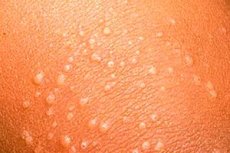Shiny lichen
Last reviewed: 23.04.2024

All iLive content is medically reviewed or fact checked to ensure as much factual accuracy as possible.
We have strict sourcing guidelines and only link to reputable media sites, academic research institutions and, whenever possible, medically peer reviewed studies. Note that the numbers in parentheses ([1], [2], etc.) are clickable links to these studies.
If you feel that any of our content is inaccurate, out-of-date, or otherwise questionable, please select it and press Ctrl + Enter.

Lish shiny (blue granuloma nitidum) is a rather rare dermatosis whose etiology and pathogenesis are not clear, is considered as a variant of red flat lichen, miliary form of annular granuloma, paratuberculous dermatosis or as an independent disease.
Pathogenesis
The histological picture is characterized by perivascular granulomas, consisting of epithelioid cells, lymphocytes, histiocytes, a few giant cells.
Pathomorphology of brilliant lichen
In the upper third of the dermis in the area of the papular element there is a dense infiltrate, closely adjacent to the epidermis, consisting of lymphocytes, histiocytes and epithelioid cells, among which giant cells of Pirogov-Langhans are sometimes found. The epidermis is somewhat flattened with smoothed zidermal protuberances. However, at the edges of the infiltrate, the zidermal processes are sometimes elongated and embrace it in the form of a "claw", which is a pathognomonic sign for this disease and distinguishes it from the red flat lichen. In the cases of the perforating form of shiny lichen in the epidermis, the phenomena of vacuolar dystrophy of cells accompanied by exocytosis are expressed.
Histogenesis is unclear. In the pathogenesis of the disease, importance is given to the allergic component, in particular to the damage of allergic vessels. Th. Naseman (I980), on the basis of the similarity of the histological pattern with shiny lichen and sarcoidosis, suggests that shiny lichen is a manifestation of an allergic reaction in sarcoidosis, but such a point of debate is not generally accepted.
Symptoms of the shiny lichen
It develops mainly in children, it manifests clinically as multiple, symmetrically located nodular eruptions of 1-2 mm in size, flat or hemispherical, with a shiny, usually not scaly surface, sometimes with slight impressions in the center, normal skin color or pale pink. The outlines of the papules are rounded, less often polygonal. Eruptions are dense, sometimes ring-shaped, most often on the skin of the penis, but can also be generalized. Atypical psoriasis, eczematoid, hemorrhagic, vesicular, perforating forms of the disease are described. The palms and soles, the nail plates, the mucous membrane of the oral cavity, the combination with the typical manifestations of the red flat lichen, the fusion of the rashes into small plaques, the positive isomorphic reaction of Kebner can be observed.
The disease is more common in children. The primary element is isolated flat papules with a diameter of 1-2 mm with a shiny, non-peeling surface, with clear boundaries, having rounded outlines, corporal or pale pink color or the color of normal skin. The most common rash is located in the area of the knee and elbow joints, on the skin of the penis. Rarely, the rash has a generalized character and can be localized on the mucous membranes. Possible damage to the palms, soles and nails. Subjective sensations are usually absent. The course of dermatosis can be prolonged.
What's bothering you?
What do need to examine?
How to examine?
What tests are needed?
Differential diagnosis
Shiny lichen should be differentiated from red flat lichen, lichenoid tuberculosis, lichenoid syphilis, styloid lichen, follicular mucinosis.
Who to contact?
Treatment of the shiny lichen
Recommended fortifying agents (vitamins A, C, D, group B, fish oil, biogenic stimulants, etc.). Out of external means, 1-2% salicylic sulfuric, salicylic-resorcinol pastes and ointments with the addition of 0.05% retinoic acid and hormonal creams and ointments are used. The effectiveness of treatment is enhanced by irradiation with ultraviolet rays. In severe forms, small doses of glucocorticosteroids are prescribed.


 [
[